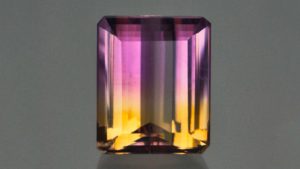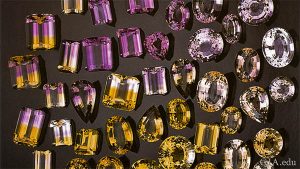Throughout the year, we have spent many blogs together diving deep into the gems associated with our birth months. November holds a special place in my heart, because my husband is a November baby. He’s fortunate to have such a lovely, warm, and inviting birthstone: citrine.
Citrine is a yellow (typically with a hint of brown or orange) variety of quartz; it almost looks like the crystals have been dipped in golden sunshine. Quartz, if you search your memories, comes in many colors, including purple (which is amethyst, the birthstone of February babies, such as yours truly). Citrine’s yellow color is caused by ferric impurities, which basically means that chemical compounds containing iron invaded the growing quartz crystal. The lovely yellow hue of citrine gave it its name. The name citrine is derived from the Old French word citrin, which means, unsurprisingly, “lemon-colored.”

Rough citrine crystal (L) and a faceted pear shaped citrine (R)
Citrine is very interesting because although it is not expensive (as far as gemstones go, that is), naturally occurring citrine is actually quite rare, with Brazil being the primary producer. Citrine comes in a wide range of yellow tones, from a light and bright slightly paler yellow known as lemon quartz, to a deep burnt orangey yellow.
Even though citrine doesn’t occur naturally as abundantly as other gemstones, we have access to quite a bit of it. This is because amethyst (and smoky quartz from certain locations) can be heated in controlled conditions to alter the color and produce citrine. This production method is the primary way we get commercially available citrine. And although we have the capability to create citrine in this way, the Earth will eventually do it also… it just takes time and heat. Not every single amethyst or smoky quartz will become citrine. It depends on the location and the natural conditions of that area. But some amethysts, when exposed to the correct conditions, will turn into the lovely yellow citrine we love. A quick note about treated versus natural stones: citrine that was formerly amethyst will sometimes have small lines in the crystal (although these are not visible to the naked eye in jewelry), but natural citrines will usually have a smoky cast to them.
Another interesting phenomenon involving citrine is a color-blocked stone called ametrine. As you probably have put together, ametrine is a combination of amethyst and citrine. The color dispersion tends to be pretty linear. There isn’t usually a large gradient or shift into the other color. The bi-color nature of ametrine occurs because of different oxidation rates of those iron-containing impurities. The oxidation rates, in turn, are caused by inconsistent heating of the crystal during its formation. Like citrine, ametrine does occur naturally, but the only place it has been found (that is viable for commercial mining, that is) is Bolivia. However, as you would guess, ametrine can be produced in a lab, by zone heating of an amethyst. Side note: this heating technique has also been applied to create other bi-color quartz gems, but in nature, the only bi-color gem that occurs is ametrine.
November babies also have an alternate birthstone at their disposal: yellow topaz. In fact, yellow topaz and citrine, if we look at them just on the basis of color, are virtually indistinguishable from each other. However, they differ in hardness on the Mohs scale (the rating system using to rank the hardness of various minerals in relation to each other). Quartz (like amethyst and citrine) has a Mohs rating of seven, whereas topaz comes in at an eight. Even though they are only one number away on the Mohs scale, the absolute hardness of topaz is literally twice that of quartz. However, since both are at least seven on the Mohs scale, they are suitable for use in jewelry.
Located in Livingston county, our downtown Brighton showroom has a lovely selection of citrine and yellow topaz jewelry. And if you are looking for something specific, but can’t find it – don’t worry! Have a seat and brainstorm a custom design with our designer. You’ll be sure to get the citrine or topaz look you want.
Until next time,
Rebecca







